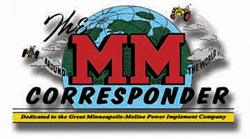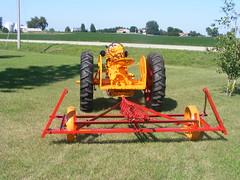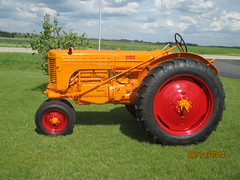As we progress into the 21st Century Twin City tractors have become highly prized collectibles with industry leading history. Perhaps the most influential design would be the 12-20. This tractor was engineered and advertised for the 1919 market year; however it is possible that ink and paper were moving to design this machine as early as 1917. By October 1918 warehouses at the Lake Street plant were full and 12-20's were already being delivered to dealers and sold to the public.
This was Minneapolis Steel & Machinery Company's first lightweight machine and was re-rated to 17-28 in 1926. It was still available through 1935, for a total production run of 17 years. The 12-20 set a designing trend for other Twin Cities and direct relationships between the 12-20 and MM tractors were apparent until 1960. This 5000 lb. machine used a vertical 4 ¼ X 6 4 cylinder 340 cubic inch engine that posted unusually high fuel economy through the use of dual camshafts and 4 valves per cylinder. At 1000 rpms 3 gallons of kerosene would produce 18.5 drawbar hp, and 28 belt pulley hp for a full hour. Two forward speeds of 2.2 and 2.9 mph were used.
When the Company's books were closed on New Year's Eve of 1919, 2900 12-20's had already been sold. Year to year breakdown of serial numbers is nearly nonexistent, but here is what we do know.
• Nearly one third of total production was sold by the end of 1919, production tapered off, and it took six more years to sell the other two thirds.
- Beginning serial number for 1918 is 10201
• First 505 units used a horizontal gas starting tank behind main tank.
• Gas starting tank was placed under the hood from # 10707 to 17034
• Starting tank was mounted vertical behind main tank from # 17035 on
• First 1,010 units used a Bosch D.U. 4. magneto with large external impulse starter
• First 1,900 units used a spring loaded Borg & Beck clutch. Over center Twin Disc starts at # 12100
• In June of 1920 # 12278 was delivered to Nebraska test lab. Results are posted under test # 19
• First 5,040 made used a Pierce governor, 8 spoke front wheels, 2 piece hand crank, and early double hump or "M" shaped intake manifold
• In 1924 carburetor and manifolding updates increased power output. Engine castings and internal dimensions remained the same
- On December 4th, 1925 production had reached #18733
• Chassis #'s 18734 - 19219 were used from December 5th, 1925 to May of 1926
• Total production from 1918 to 1926 was just over 9,000 units using serial #'s 10201 - 19219
~Tony Thompson








